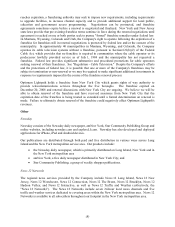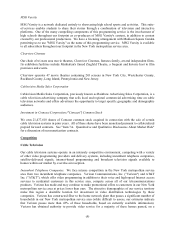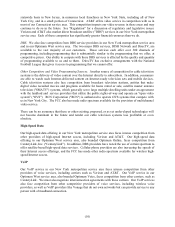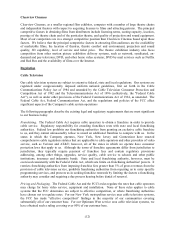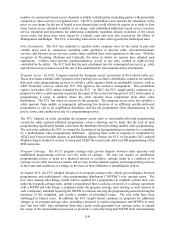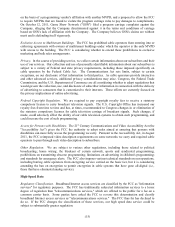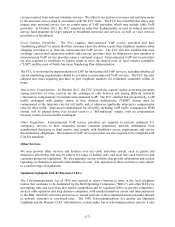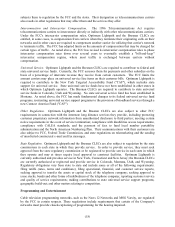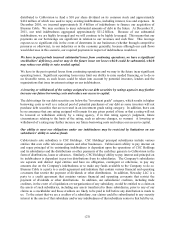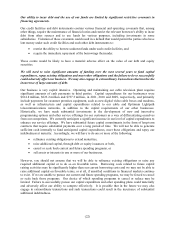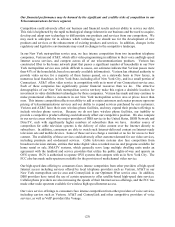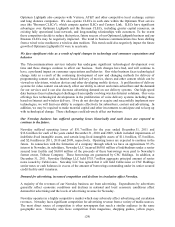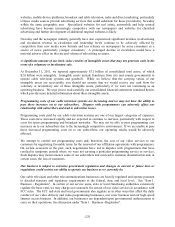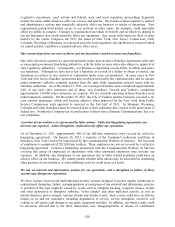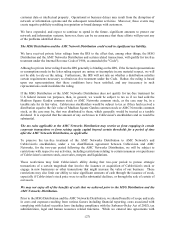Cablevision 2011 Annual Report Download - page 23
Download and view the complete annual report
Please find page 23 of the 2011 Cablevision annual report below. You can navigate through the pages in the report by either clicking on the pages listed below, or by using the keyword search tool below to find specific information within the annual report.(17)
revenues earned from end user interstate services. We allocate our end user revenues and remit payments
to the universal service fund in accordance with the FCC order. The FCC has ruled that that states may
impose state universal service fees on certain types of VoIP providers, which may include cable VoIP
providers. In October 2011, the FCC adopted an order that fundamentally revised its federal universal
service fund programs to target support to broadband networks and services, as well as voice services
provided over broadband.
Local Number Portability. The FCC requires interconnected VoIP service providers and their
"numbering partners" to ensure that their customers have the ability to port their telephone numbers when
changing providers to or from the interconnected VoIP service. The FCC also has clarified that local
exchange carriers and commercial mobile radio service providers have an obligation to port numbers to
interconnected VoIP service providers upon a valid port request. Interconnected VoIP service providers
are also required to contribute to federal funds to meet the shared costs of local number portability
("LNP") and the costs of North American Numbering Plan Administration.
The FCC is reviewing the implementation of LNP for interconnected VoIP services, including whether all
current numbering requirements should be extended to interconnected VoIP services. The FCC has also
adopted new rules requiring providers to port telephone numbers for residential customers within 24
hours.
Intercarrier Compensation. In October 2011, the FCC revised the current regime governing payments
among providers of voice services for the exchange of calls between and among different networks
("intercarrier compensation") to include interconnected VoIP. The FCC clarified that prospectively, VoIP
traffic exchanged with another carrier in time division multiplexing ("TDM") format must be
compensated at the interstate rate for toll traffic and at otherwise applicable intercarrier compensation
rates for other traffic. Intercarrier compensation for all traffic, including VoIP traffic exchanged in TDM
format, will be phased down over several years to a "bill-and-keep" regime, with no compensation
between carriers for most traffic exchanged.
Other Regulation. Interconnected VoIP service providers are required to provide enhanced 911
emergency services to their customers; protect customer proprietary network information from
unauthorized disclosure to third parties; and comply with disabilities access requirements and service
discontinuance obligations. Interconnected VoIP service providers are also required to be compliant with
CALEA standards.
Other Services
We may provide other services and features over our cable television system, such as games and
interactive advertising, that may be subject to a range of federal, state, and local laws such as privacy and
consumer protection regulations. We also maintain various websites that provide information and content
regarding our businesses and offer merchandise for sale. The operation of these websites is also subject
to a similar range of regulations.
Optimum Lightpath and the Bresnan CLECs
The Telecommunications Act of 1996 was enacted to remove barriers to entry in the local telephone
market that continues to be dominated by the Bell Operating Companies ("BOCs") and other ILECs by
preempting state and local laws that restrict competition and by requiring ILECs to provide competitors,
such as cable operators and long distance companies, with nondiscriminatory access and interconnection
to the BOC and ILEC networks and access to certain portions of their communications networks (known
as network elements) at cost-based rates. The 1996 Telecommunications Act entitles our Optimum
Lightpath and the Bresnan CLEC subsidiaries to certain rights, but as telecommunications carriers, it also



